This is a complete step-by-step guide to creating an effective email marketing strategy.
Whether you're a seasoned marketer or just starting, this guide will help you navigate the essential steps to build a robust email marketing strategy that drives results.
You’ll learn how to:
- Set email marketing goals
- Identify trends
- Monitor your competition
- Audit your audience
- Grow email lists
- Segment your database
- Pick newsletter types
- Check legal requirements
- Create newsletter templates
- Determine sending frequency
- Create newsletter content
- Select visuals
- Run deliverability check
- Measure your results
Let's start!
1. Set email marketing goals
Setting clear goals should be your starting point: goals give you direction and help you measure the success of your newsletters. After identifying specific goals, you can move forward on planning your newsletter templates, visuals, copy, and other important aspects of email marketing.
Note: goals should help you achieve your business goals. In other words, email marketing is just a weapon for helping you achieve bigger goals, not a goal itself.
Let’s compare these email marketing goals and the steps for attaining them:
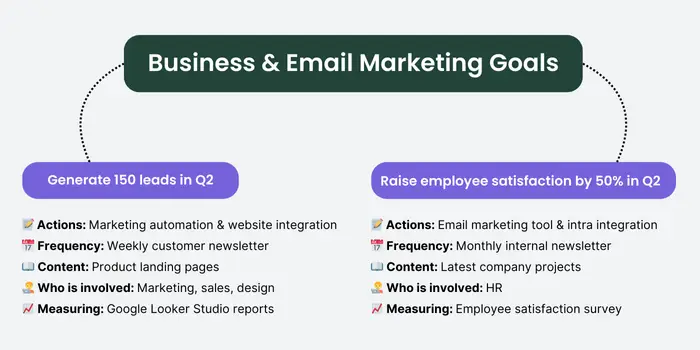
2. Identify trends
You probably don’t want to read a newsletter with an outdated design or old slang. That’s why trendwatching should be added to your email marketing strategy.
Keep an eye on the latest trends and start using them before they become mainstream. Follow what is talked about in your industry and keep up with new features in email marketing.
In 2024, trendy newsletters are made of:
- 3D Design
- Minimalism
- Vibrant colors
- Abstract gradients
- Animated GIFs
- Storytelling in graphics and videos
- Personalization
- Interactive Emails
At Liana, we are bringing interactivity to the newsletters through polls. This creates a channel of communication with the newsletter recipient. We also share the poll responses from previous newsletters in the letters.
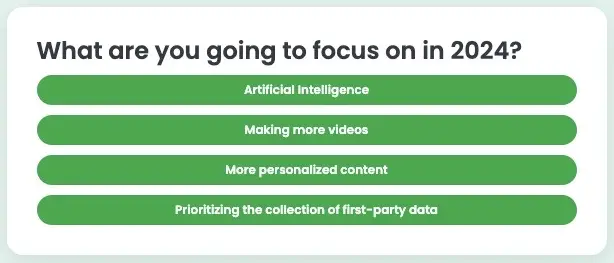
However, it is not worth following trends at the expense of functionality. Keep your email template simple – too heavy email weight can affect your deliverability.
3. Monitor your competition
Spy on your competitors to see what newsletters others create and how they approach email marketing in general. Analyze content, frequency, and engagement tactics, and use these insights to refine your email marketing strategy.
You can also find email marketing ideas and tips from Liana’s newsletter. Subscribe below!
4. Audit your audience
The good ol’ buyer persona concept is a good way to start analyzing your target audience. This way you can tailor your emails to match your audience's needs and preferences. Analyzing your audience can also give you some hints for your content marketing in general.
Analyze, for example, these factors:
- What email clients do they use
- When they are most active (check the reports in your email tool to see when your newsletters are mostly opened)
- What devices are popular among them
- Their engagement patterns (which types of content get the most clicks and responses)
Here’s what your audience portrait might look like:
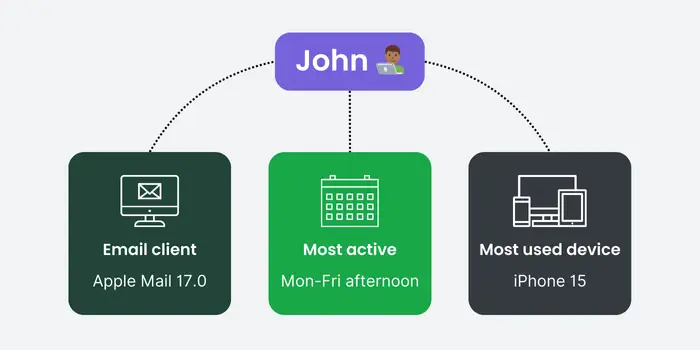
5. Grow email lists
In case you don’t have a contact database yet, now’s the time to start building one. Here are some of the ways to grow an email list from scratch:
- Visible subscription forms: Make it easy for visitors to subscribe to your newsletter by placing forms prominently on your site.
- Offer discounts: Encourage sign-ups by offering discounts or special deals in exchange for email addresses.
- Create downloadable content (= lead magnets): Offer valuable resources like eBooks, guides, or whitepapers that users can download in exchange for their email addresses.
- Provide free Wi-Fi: Offer free Wi-Fi at your physical locations in exchange for an email address.
- Leverage LinkedIn newsletters: Start a LinkedIn newsletter and direct subscribers to your actual newsletter.
- Offer early access invitations: Provide early access to new products or services to those who subscribe.
- Promote on social media: Add a “Subscribe to our newsletter” link on all your social media platforms.
- Utilize event or webinar attendees: Add attendees of your events or webinars to your mailing list, with their permission.
- Advertise in-store and on print materials: Promote your newsletter in physical stores and through printed materials like flyers and business cards.
- Create online quizzes: Engage users with online quizzes and send results to those who provide their email addresses.
Focus on organic list-building
We recommend focusing on organic list-building techniques – purchased contact lists have poor engagement, damage your sender's reputation, lower your deliverability, and also have legal risks.
Ensure Data Responsibility
Take also data responsibility into account and collect only relevant data from your contacts. Ensure compliance with GDPR and other privacy regulations when collecting and storing email addresses.
6. Segment your database
Today’s email marketing is all about reaching your audience on a personal level. Personalized emails can significantly boost your revenue and engagement rates.
Segmenting your email lists is crucial for sending personalized emails. You can segment your lists based on your industry and needs.
Here are some common segmentation criteria:
- Geography
- Age
- Gender
- Company
- Industry
- Job title
- Past purchases
- Event participants
- Cart abandonment (for eCommerce)
How to segment your email lists?
- Ask the right questions in your subscription forms: If you plan to send newsletters based on geography, make the location a mandatory field on your forms.
- Use dynamic lists: Many email marketing tools can automatically compile new lists from your existing users based on the criteria you set.
7. Plan newsletter types
Now it’s time to think about the topic clusters or types of newsletters you want to send. Here are the most common types of newsletters:
- Promotional: upselling, new product announcements, webinar invitations
- Behavioral: welcome newsletters, “we miss you” emails, cart abandonment
- Informational: CEO updates, Terms of Service
- Transactional: order confirmations, shipping notifications, account updates, password resets
Consider which types of newsletters align with your goals and email marketing strategy to ensure you deliver the right content to your audience.
Here at Liana, we are committed to sending monthly newsletters, product updates to customers, as well as webinar-related emails, such as invitations, registration confirmations, and webinar recordings.
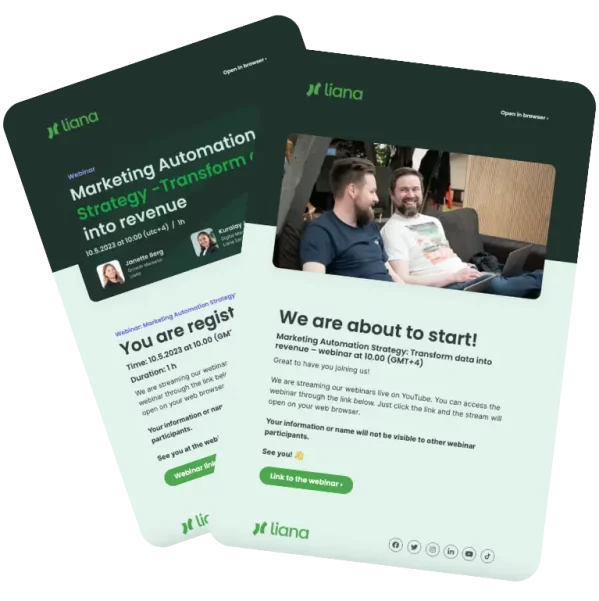
8. Check legal requirements
Make sure your actions are following GDPR regulations. Each member of your team should be familiar with the key rules:
- Obtain explicit consent: It's mandatory to obtain users' consent for email marketing. Use double-opt-in messages to ensure explicit consent.
- Avoid purchased email lists: Companies are prohibited from sending unsolicited commercial emails by purchasing email lists. Focus on building your own opt-in subscriber base.
- Include opt-out options: All email communications must include an opt-out functionality (an unsubscribe button) and a physical locator (corporate address).
- Beware of significant fines: Organizations in breach of GDPR can face significant fines, up to 4% of annual global turnover or €20 million, whichever is greater.
Ensure your email marketing provider complies with local privacy regulations, such as GDPR. Check their policies and procedures for handling user data.
9. Create newsletter templates
Whether you’re using ready-made email templates or creating customized ones with your email marketing software provider, it's essential to include key components in your newsletter template.
Vital components of a newsletter
Let’s take a look at these must-have newsletter components:
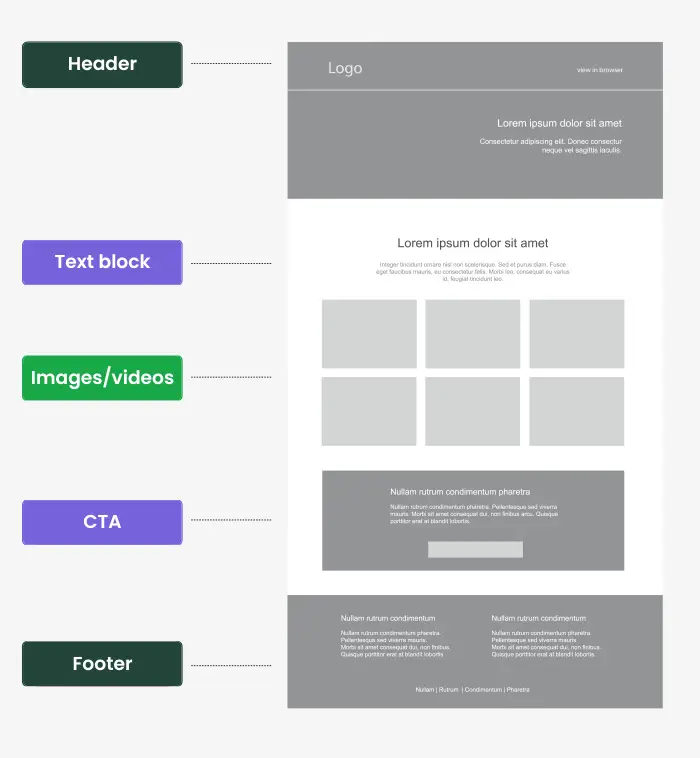
- Header: Add your logo and a link to view your newsletter in the browser.
- Text block: Make sure your heading style stands out.
- Call-to-Action (CTA): Direct readers to your site or landing pages with enticing CTA copy.
- Footer: Add your contact information and an unsubscribe link.
Build accessible newsletters
Today’s digital content should be accessible to all, including people with different kinds of disabilities. Here’s a checklist to ensure your newsletters are accessible:
- Logically placed and scannable sections
- Alt tags for images to provide context
- Contrasting and consistent color scheme for readability
- Descriptive and clear text
- Descriptive subject line
Mobile-friendly design
Ensure your template is mobile-friendly to accommodate users on various devices, including those using dark mode settings. Utilize responsive design techniques to adapt your layout and content for different screen sizes, ensuring readability and usability across smartphones and tablets.
10. Determine sending frequency
There are tons of studies on “best times to send emails”, but they often overlook diverse time zones and online habits of your audience.
That’s why you should decide on the frequency and the sending time for your newsletters that work for your company. Some tips to remember:
- Use scheduling feature: This is a huge time-saver if you plan newsletters well in advance or need to reach your readers on weekends.
- Respect your readers: Stick to the frequency you promised. Do not send emails every week if you promised monthly sendings, and vice versa.
- Send regularly: Consistent sending patterns build trust and set you apart from spammers, who often send irregularly. By maintaining a predictable schedule you demonstrate reliability and commitment.
- Always reserve space for ad-hoc newsletters: Keep flexibility in your schedule to accommodate unexpected communications or timely updates, ensuring you can adapt to evolving circumstances.
Marketing automation helps with staying consistent in email marketing. It facilitates automated communications and segmentation, and ensures timely follow-ups, making your email marketing efforts more efficient. Check out our webinar recording:
Note! To see the video above, give cookie consent to the Marketing section. Open cookie manager.
11. Create newsletter content
The next step is to curate compelling content for your newsletter. Focus on creating valuable, relevant, and engaging content. Employ storytelling and keep your tone consistent with your brand voice.
Here are some tips to help you plan engaging content:
Editorial calendar
Use an editorial calendar to organize and plan your newsletter content effectively. You can create your own calendar using spreadsheets, or explore various online templates available for free.
Plan in advance
Start early enough, especially if you need to involve others for your newsletter content. Asking your CEO to give a quote for your newsletter one day before the actual sending might be too late.
Utilize newsletter content to its maximum potential
Your newsletter content can serve multiple purposes. Consider repurposing newsletter content for press releases or other marketing materials, maximizing its reach and impact across various channels.
Pay attention to all newsletter content
Check your subject line and preheader to ensure you have unique content in all components of your newsletter.
Personalize the content
Tailor every aspect of your newsletter content for maximum engagement. Utilize the features of your email marketing tool, such as A/B testing, when personalizing your newsletter.
In LianaMailer, you can also personalize different content blocks of your newsletter by the recipient.
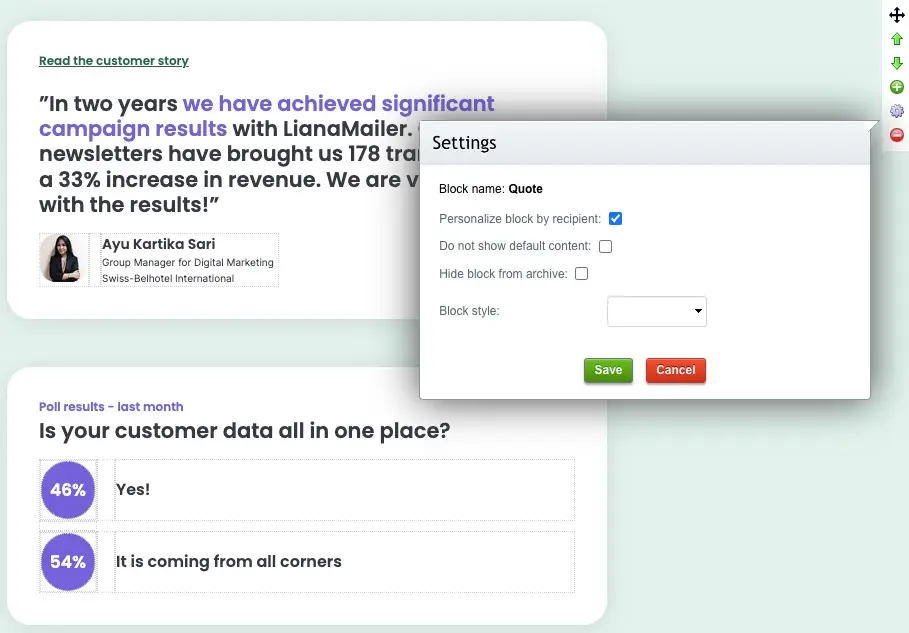
Interactive emails
Incorporate interactive elements, like polls and surveys, within your newsletters to increase engagement.
Leverage AI
Try artificial intelligence (AI) to streamline your newsletter content creation process. AI-powered tools can generate engaging subject lines, copy snippets, and entire articles based on your data and wishes.
Some tools already utilize AI features within the tool itself. For example, LianaMailer has a built-in AI Assistant, which quickly generates texts based on your request.
12. Select visuals
We all create the first impression of a company when checking their social media and website visuals. The same goes for your newsletter images. Pay enough attention to selecting good visuals for your emails.
Images
- Use only high-quality images: Blurry or pixelated photos do not look professional.
- Shoot your own photos: Using stock images is always an option but personal photos create friendlier and more authentic vibes.
- Add links to images: Boost newsletter click-through rates by adding relevant links to all images you use.
- Keep the right image-to-text ratio: Your newsletter may end up in spam if the amount of text is not in balance with your images. Professional email tools tell you this before you hit the send button.
- Avoid large image uploads: Newsletters containing heavy files are slower to upload and have higher spam points.
Large images can cause newsletters to be clipped in email clients, often due to exceeding size limits around 102KB. This results in important content being cut off and can lower engagement rates. To avoid clipping, compress your images and use smaller file sizes to ensure the entire message is visible.
Online tools for creating images
Short on resources? Try one of these free online tools for creating infographics or simple images:
- Canva
- Snappa
- VistaCreate
- Piktochart
GIFs
GIFs are good content to add movement and visual interest to your newsletter. They are also a great way to demonstrate actions and draw attention to a certain block or text. You can also use them to add humor or personality to your content.
Test GIFs across various email clients to ensure compatibility and consistent display.
Videos
We’re living in the era of videos, which is why it's essential to include videos in your newsletters, too.
This is how the video element looks in Liana’s newsletters.
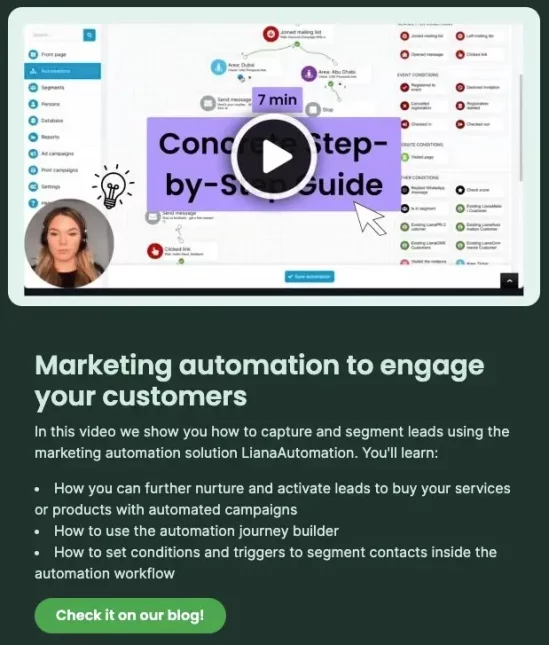
Online tools for creating videos
If in-house video production is out of your budget, check these tools for creating engaging video content:
- Promo
- Animoto
- Canva
- Vidyard
- Lumen5
- Kapwing
13. Run deliverability check
Did you know that a bounce rate of 10% and higher might be alarming? Here are some deliverability tips from our specialists:
- Monitor bounces and inactives: Keep an eye on hard and soft bounces as well as inactive recipients. Persistently emailing these addresses can harm your sender's reputation.
- Reconfirm or remove inactive subscribers: To maintain a healthy list and reduce bounce rates, consider sending a reconfirmation email to inactive subscribers periodically. Or just remove them entirely.
- Target recipients carefully: Sending emails to users who don't read them or mark them as spam when the content is irrelevant will harm your delivery metrics and reputation.
- Check plain text version: Ensure your email has a readable plain text version, as some users won't see images by default.
- Avoid problematic elements: Exclude HTML forms, JavaScript, and embedded objects (like Flash or ActiveX) from your emails.
- Authenticate your emails: Use SPF, DKIM, and DMARC to authenticate your emails and improve deliverability.
14. Measure your results
Wouldn’t it be great to plan your marketing based on real data instead of guesswork?
If you just nodded, be ready to monitor the success of your newsletters regularly. Here are some of the key metrics to focus on.
Top metrics of email success:
- Open Rate (OR)
- Click-Through Rate (CTR)
- Click-to-Open Rate (CTOR)
- Unsubscribe Rate
- Bounce Rate
- Conversions
- Return on Investment (ROI)
- Engagement Time
Tools for monitoring your email marketing results:
- Built-in reporting tools: Most email marketing providers offer comprehensive reporting features that track essential metrics such as OR, CTR, bounce rate, and unsubscribes.
- Google Analytics: Use UTM parameters to track website traffic, conversions, and user behavior from your newsletters.
- Google Looker Studio: Visualize and analyze how your email marketing performs against other marketing channels.
Interested to hear more?
Get familiar with our newsletter tool LianaMailer, and feel welcome to contact our experts to further discuss improving your newsletters.
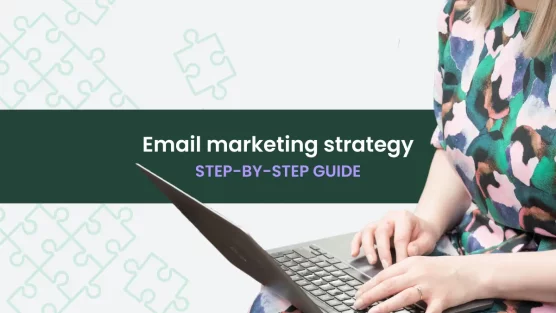



Comment
Comments
No comments